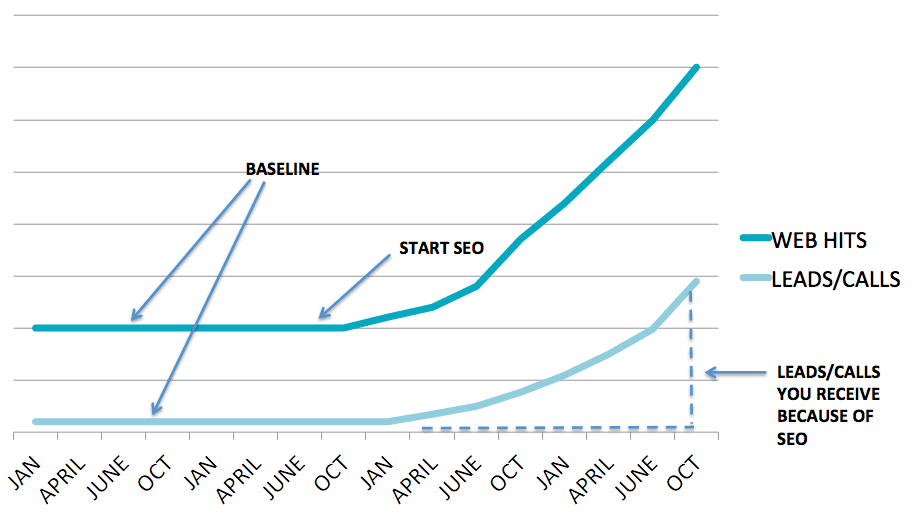How to Calculate ROI on SEO
How do you know if your SEO efforts are successful? Here’s a quick and simple method to calculate the ROI of your SEO.
Being a digital marketing agency that offers SEO as a service, we’ve often been asked the following question by our clients: “I get why I should have good search engine rankings, but how do I know it’s actually going to make me money?”
If you’re a business owner and have wondered the same thing, then you’ll find your answers within this post. Whether you want to handle your SEO in house or hire an agency to handle it for you, our simple goal in this post is to give you a way to evaluate the investment you make (in the form of time or money).

Here are four steps for setting up your SEO strategy so you can evaluate your ROI.
1. Determine your most profitable offerings.
Where do you make the most money? How do customers find those moneymakers? The first step to a successful SEO strategy is to determine which of your products and services are most important to your business.
Suppose you’re an electrician who sells standby generators. Chances are, you’re making more money on standby generators than on basic electrical services. First and foremost, a sound strategy would be to optimize for keywords relevant to “standby generators” in your geographical area.
2. Determine your “baseline” site traffic
You must establish a “baseline” traffic level so you understand the answers to two future questions:
- How much traffic was my site receiving before the SEO began?
- How much traffic is attributable to my SEO efforts?
The “baseline” is the amount of traffic your website already receives and is the amount of traffic for which our SEO efforts must not receive future attribution. In other words, if your website has been drawing 1000 monthly unique visitors for the past two years, then 1,000 is the “Baseline” and has nothing to do with the SEO efforts employed. You must also determine a baseline for other important metrics, including tracked phone calls, website form submissions, and “walk-in traffic.” This will become more important when we get into the nuts and bolts of determining ROI.
3. Establish your most important search terms.
Continuing with our prior example, let’s assume our electrician wants to sell more standby generators. The next step is to determine the search terms and keywords that will likely bring target customers to the website. Those keywords should be listed in an initial ranking report to provide a baseline understanding of where you currently stand on a search results page. See an example here:
4. Evaluate SEO improvements.
Now that you’ve determined where you stand currently, it’s time to get to work on your SEO strategy. Strong SEO can take months and years to develop, so patience and commitment are the keys to success. Each month you’ll need to track where you rank in relation to what was established on your “Initial Ranking Report.”
Let’s start with a set of assumptions:
- People research online when they are purchasing products and services, including yours. (i.e. your customers are using the internet often)
- Since people are shopping online for products and services, it’s important that your website be part of the conversation and be visible in relevant search results.
- Since you want your website to be visible, you also want people to visit it.
- Search Engine Optimization increases website visibility, which ultimately increases hits.
- Since people use the internet, and website hits are important, it is assumed that increased website hits ultimately deserve partial attribution for increases in overall revenue. This is the most important item to understand and agree on before delving into SEO.
In short: Increased website hits = increased revenue.
The ROI Calculation: It all starts with an increase in website traffic.

Earlier we discussed the “baseline traffic level,” and we used 1,000 unique monthly visitors as the example. Now, let’s take that 1,000 unique visitors and compare it with the other metrics that are important to your business, such as,
- Tracked phone calls
- Website form submissions
- “Walk In” traffic
Since we’ve established that website visitors = revenue, we can assume that an increase in phone calls, form submissions and “walk in” traffic can be partially attributed to an increase in website visits. There might be other factors that affect the number of people who walk into your establishment, but the website is the primary driver. So, if your monthly unique website hits rises to 2,300 over a one year period, and your other metrics increase as well, the increase in those other metrics can be attributed to your SEO strategy. When you determine a closing rate on the other metrics, and a “revenue per customer,” you can easily determine an ROI on your SEO.
Here’s an example of some basic site analytics:
July 2017
- Website traffic above baseline: 1,300 unique visitors (130% increase)
- Tracked Phone Calls: 23 over baseline (73% increase)
- Form Submissions: 17 over baseline (82% increase)
- Walk-In Traffic: 67 over baseline (43% increase)
- Overall closing rate: 5%
- Lifetime revenue per customer: $623
Now it’s just a simple calculation:
- Total New Opportunities (107) * Closing Rate (10%) * $623 = $6661
- Top Line Revenue Growth
- Monthly SEO Spend: $1,500
- Total Return Attributable to SEO Efforts: $5166
- ROI % = 344%
It might seem crazy, but this type of return is not atypical when it comes to evaluating SEO spend. This is especially true if you have a higher closing % or higher lifetime revenue per customer.
Common valid questions about this formula
“I don’t really believe the SEO was solely responsible for all these increases. We’ve been doing lots of things to collectively help our business. How can I account for those items in this ROI calculation?”
The easiest way to account for other items in this formula is to work cohesively with your SEO company to agree on those differences ahead of time. That way, there are no surprises or disputes regarding attribution.
Some situations that can throw off the SEO ROI calculation include:
- An overall increase in business in the marketplace: You know the old saying – “Rising tides lift all boats.” A strong SEO strategy can’t take credit for all increases in site traffic, form submissions, etc. To plan for this, perhaps everyone agrees to an 80% attribution in favorable market conditions. For instance, if the government releases a new tax credit for standby generators, we can assume our electrician would sell more of them regardless of SEO. Therefore, SEO can’t take credit for all additional hits and sales. So what’s the right attribution percentage? I doesn’t really matter, as long as it’s consistent and everyone agrees to it.
- An increase in other advertising: If a business decides it will do a lot of TV or Radio advertising in a given month, assume it will create an increase in website traffic. How much? Undetermined. However, simply accounting for these additional advertisements will go a long way in helping everyone come to a mutual agreement on the SEO strategy’s ROI.
“What if I’m getting an increase in web traffic but nothing else is increasing?”
If your website isn’t converting visitors into leads, consider making improvements to your website like:
- Improving user (customer) experience: How easy is your site to navigate? How many clicks does it take for the consumer to find what they want?
- Adding new forms and conversion points: Is your “contact us” page the only spot where the customer can submit a form? If so, you’re likely costing yourself leads. Consider that customers might be shopping your website in the wee hours of the night or on the weekends when you’re closed, so you can’t simply count on them to call you. There must be a way for them to get answers to their questions on their terms.
- Adding phone numbers in various locations: Can the user easily find your phone number? Is your phone number visible on every page?
- Making your site mobile friendly: Most of your visitors are coming to your site via a mobile device. “Pinching” and “expanding” takes too much time and many people will simply bounce off your site. If your site isn’t mobile-friendly, you’re costing yourself dearly.
SEO is a great way to increase your business’ visibility and bottom line, but beginning a strategy without proper planning is likely to result in failure. Unfortunately, most SEO campaigns don’t really start bearing fruit until 3-6 months after inception, so it’s important to stick with it! Here are some examples of results you can expect if you let us handle it for you.
Want more information on increasing your traffic, phone calls and form submissions? Click here to start a conversation and we’ll help you design and implement a strategy that will help you dominate your competition and win more business.



